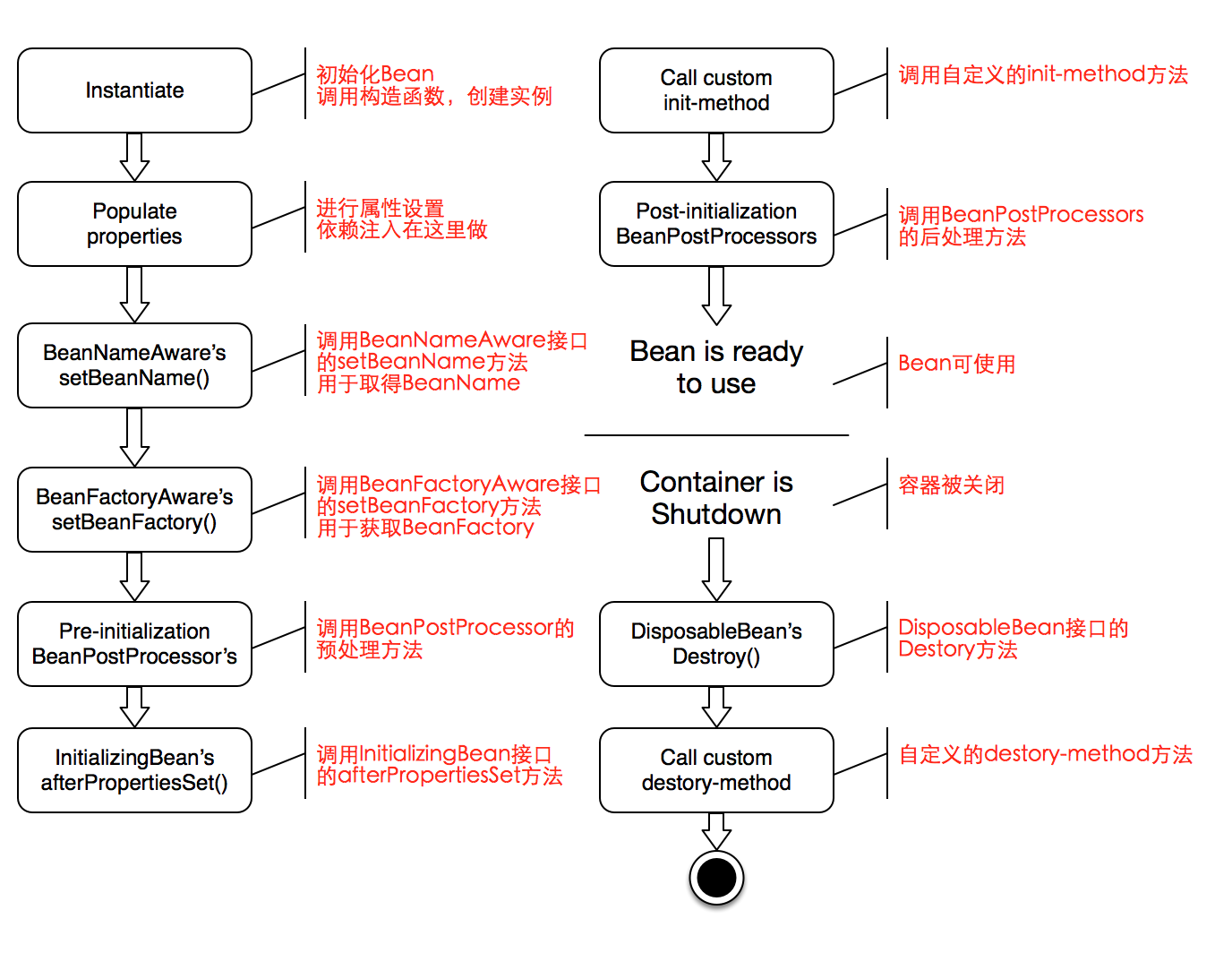我理解的Bean生命周期包括两个方面:
- Bean何时创建,何时销毁
- Bean从创建到销毁的执行流程
一、Bean创建与销毁
Bean的创建时机主要由几个配置项共同来决定,包括:
- scope属性,决定是Bean是单例模式(singleton)还是多例模式(prototype),默认为单例singleton;
- lazy-init属性,只对单例模式有效,决定是否延时加载,默认为false,表示在容器初始化时,就会生成单例;
- RequestMapping属性,这个注解MVC中才有,当有该属性时,lazy-init属性会失效(其实不是简单的冲突,而是RequestMapping会在另外的逻辑处理中生成单例);
1.scope属性
主要有两个枚举,singleton与prototype,默认值为singleton。
1.1配置scope,如果不配置,默认值都为singleton
- xml配置
<bean id="loginService" class="com.springapp.mvc.service.impl.LoginServiceImpl" scope="prototype"/>- 注解配置,直接使用@Scope注解
@Scope(value=ConfigurableBeanFactory.SCOPE_PROTOTYPE)1.2 枚举含义
- singleton,表示单例模式,这个很好理解,表示在容器中,只存在该Bean的一个实例,每次请求Bean时,返回的都是同一个。例:
//例1.2.1
@Component
public class Person {
public Person(){
System.out.println("Person 初始化...");
}
public static void main(String args[]){
BeanFactory beanFactory = new ClassPathXmlApplicationContext("mvc-dispatcher-servlet.xml");
System.out.println("容器初始化完成");
Person person1 = (Person) beanFactory.getBean("person");
Person person2 = (Person) beanFactory.getBean("person");
System.out.println(person1.equals(person2));//同一个实例,打印true
}
}
输出:
Person 初始化...
容器初始化完成
true- prototype,表示每次请求Bean时,都会新建一个Bean实例,例:
//例1.2.1
//上例中,在类前加一个注解:
@Scope(value = ConfigurableBeanFactory.SCOPE_PROTOTYPE)
输出:
容器初始化完成
Person 初始化...
Person 初始化...
false2.lazy-init属性
一个布尔型的枚举,就两个值true与false,默认值为true。这个配置只在scope=singleton时有效
2.1 配置lazy-init,默认值为true
- xml中配置
<bean id="loginService" class="com.springapp.mvc.service.impl.LoginServiceImpl" lazy-init="true"/>- 注解配置,使用@Lazy注解
//在类前使用
@Lazy2.2 枚举含义
- lazy-init=false,表示容器在初始化时,就会创建单例Bean,这个是默认配置,所以例1.2.1中,先打印“Person 初始化…”,再打印“容器初始化完成”
- lazy-init=true,在初次getBean时,才会去创建Bean,例
//例2.2.1
//在Person类前添加注解@Lazy
输出:
容器初始化完成
Person 初始化...
true3.配置嵌套
主要指singleton与prototype两种不同Bean的相互引用,更具体的来说,其实是singleton对prototype的引用。因为相互引用一共就四种方式,有三种结果非常明确,即:
- prototype或singleton引用singleton,因为singleton在容器中只会有一个实例,所以结果肯定都是引用同一个类;
- prototype引用prototype,重新创建的实例再次注入新的依赖,肯定还是会重新创建的。
所以,只剩singleton对prototype的引用,一开始我就理解错误,以为prototype每次都会变,如下实例:
//例3.1
@Component
@Scope(value = ConfigurableBeanFactory.SCOPE_PROTOTYPE)
public class Apple {
public Apple(){
System.out.println("Apple 初始化...");
}
}
@Component
public class Person {
@Resource
Apple apple;
public Person(){
System.out.println("Person 初始化...");
}
public void eat(){
System.out.println("Apple hashcode="+apple.hashCode());
}
public static void main(String args[]){
BeanFactory beanFactory = new ClassPathXmlApplicationContext("mvc-dispatcher-servlet.xml");
System.out.println("容器初始化完成");
Person person1 = (Person) beanFactory.getBean("person");
Person person2 = (Person) beanFactory.getBean("person");
person1.eat();
person2.eat();
}
}
输出:
Person 初始化...
Apple 初始化...
容器初始化完成
Apple hashcode=10745331
Apple hashcode=10745331 本来以为,每次获取Person的Bean时,都会重新注入Apple,结果证明注入只会在Bean创建时进行一次,后续getBean时,发现单例Person存在,直接就会返回该实例,不会重新进行注入操作。
但是如果有这种需求,就是需要每次都重新创建新的Apple,如何实现呢?在网上查询了一下资料,需要使用lookup-method属性配置。
4 lookup-method属性
这个属性用于singleton的Bean中获取prototype的Bean,实现每次调用都重新创建新的Bean。
4.1 原理
用户自己指定一个Bean注入时的方法,然后使用Bean时调用这个方法获取。Spring容器会自动用cglib替换方法体,动态调用getBean获取Bean并返回。看看源码:
//1.解析lookup-method属性并注册
//org.springframework.beans.factory.xml.BeanDefinitionParserDelegate#parseLookupOverrideSubElements
/**
* Parse lookup-override sub-elements of the given bean element.
*/
public void parseLookupOverrideSubElements(Element beanEle, MethodOverrides overrides) {
NodeList nl = beanEle.getChildNodes();
for (int i = 0; i < nl.getLength(); i++) {
Node node = nl.item(i);
if (isCandidateElement(node) && nodeNameEquals(node, LOOKUP_METHOD_ELEMENT)) {
Element ele = (Element) node;
String methodName = ele.getAttribute(NAME_ATTRIBUTE);
String beanRef = ele.getAttribute(BEAN_ELEMENT);
//新建lookup重载对象
LookupOverride override = new LookupOverride(methodName, beanRef);
override.setSource(extractSource(ele));
//注册到Bean定义中
overrides.addOverride(override);
}
}
}
//2.调用lookup-method方法时,调用cglib替换后的代码,再去调用getBean,具体方法没去研究,有时间看看
//org.springframework.beans.factory.support.CglibSubclassingInstantiationStrategy.LookupOverrideMethodInterceptor#intercept
@Override
public Object intercept(Object obj, Method method, Object[] args, MethodProxy mp) throws Throwable {
// Cast is safe, as CallbackFilter filters are used selectively.
LookupOverride lo = (LookupOverride) getBeanDefinition().getMethodOverrides().getOverride(method);
Object[] argsToUse = (args.length > 0 ? args : null); // if no-arg, don't insist on args at all
if (StringUtils.hasText(lo.getBeanName())) {
//有beanName,优先使用beanName匹配
return this.owner.getBean(lo.getBeanName(), argsToUse);
}
else {
//没有配置beanName,尝试使用类型去匹配,如果匹配到多个,会抛异常
return this.owner.getBean(method.getReturnType(), argsToUse);
}
}4.2 配置lookup-method
- xml配置
<bean id="person" class="com.springapp.mvc.service.Person">
<lookup-method bean="apple" name="getApple"/>
</bean>- 注解配置,使用@Lookup在方法前配置
@Lookup
public Apple getApple(){
//方法体由Spring自动实现
return null;
}配置后,测试一下:
//例4.1
@Component
public class Person {
public Person(){
System.out.println("Person 初始化...");
}
public void eat(){
Apple apple = getApple();
System.out.println("Apple hashcode="+apple.hashCode());
}
public static void main(String args[]){
BeanFactory beanFactory = new ClassPathXmlApplicationContext("mvc-dispatcher-servlet.xml");
System.out.println("容器初始化完成");
Person person1 = (Person) beanFactory.getBean("person");
Person person2 = (Person) beanFactory.getBean("person");
person1.eat();
person2.eat();
}
@Lookup
public Apple getApple(){
return null;
}
}
测试输出:
Person 初始化...
容器初始化完成
Apple 初始化...
Apple hashcode=1528848756
Apple 初始化...
Apple hashcode=719205737对比例子4.1与3.1,可以看到实现了每次调用Apple都重新创建的功能,当然,有人可能会问,这样写与自己去实现getApple的方法体,去new一个对象有什么区别呢?还是为了解耦,这样写的好处就是Apple的创建依然交给Spring,Person不依赖于Apple的实现。
二、Bean的执行流程
1.流程图
首先上一张老图,这里主要是用BeanFactory来初始化容器时,创建Bean会经历的流程。如果使用ApplicationContext,则会有很多额外处理与功能。
2.Spring源码,Bean的创建与初始化
org.springframework.beans.factory.support.AbstractBeanFactory#doGetBean
protected <T> T doGetBean(
final String name, final Class<T> requiredType, final Object[] args, boolean typeCheckOnly)
throws BeansException {
...
return createBean(beanName, mbd, args);
...
}
org.springframework.beans.factory.support.AbstractAutowireCapableBeanFactory#createBean
/**
* Central method of this class: creates a bean instance,
* populates the bean instance, applies post-processors, etc.
* @see #doCreateBean
*/
@Override
protected Object createBean(final String beanName, final RootBeanDefinition mbd, final Object[] args)
throws BeanCreationException {
//查找Bean相关的类
// Make sure bean class is actually resolved at this point.
resolveBeanClass(mbd, beanName);
// Prepare method overrides.
...
//检查重载(字面意思,非对象继承)方法是否存在
mbd.prepareMethodOverrides();
// Give BeanPostProcessors a chance to return a proxy instead of the target bean instance.
Object bean = resolveBeforeInstantiation(beanName, mbd);
...
//创建Bean
Object beanInstance = doCreateBean(beanName, mbd, args);
...
return beanInstance;
}
/**
* Actually create the specified bean. Pre-creation processing has already happened
* at this point, e.g. checking {@code postProcessBeforeInstantiation} callbacks.
* <p>Differentiates between default bean instantiation, use of a
* factory method, and autowiring a constructor.
* @param beanName the name of the bean
* @param mbd the merged bean definition for the bean
* @param args arguments to use if creating a prototype using explicit arguments to a
* static factory method. This parameter must be {@code null} except in this case.
* @return a new instance of the bean
* @throws BeanCreationException if the bean could not be created
*/
//真正创建Bean的地方
protected Object doCreateBean(final String beanName, final RootBeanDefinition mbd, final Object[] args) {
// Instantiate the bean.
...
//创建Bean实例,会调用构造函数
instanceWrapper = createBeanInstance(beanName, mbd, args);
...
//进行属性设置
populateBean(beanName, mbd, instanceWrapper);
...
/*
org.springframework.beans.factory.support.AbstractAutowireCapableBeanFactory#initializeBean
初始化Bean,按顺序包括:
1.BeanNameAware,BeanClassLoaderAware,BeanFactoryAware的对应接口方法
2.BeanPostProcessor的预处理postProcessBeforeInitialization
3.InitializingBean接口的afterPropertiesSet
4.自定义的init-method方法
5.BeanPostProcessor的后处理postProcessAfterInitialization
*/
exposedObject = initializeBean(beanName, exposedObject, mbd);
...
// Register bean as disposable.
//注册DisposableBean,只对singleton的Bean处理
registerDisposableBeanIfNecessary(beanName, bean, mbd);
return exposedObject;
}3.测试代码
public class Person implements BeanNameAware,BeanFactoryAware,BeanClassLoaderAware,InitializingBean,DisposableBean,ApplicationContextAware {
public Person(){
System.out.println("Person 初始化...");
}
public static void main(String args[]){
BeanFactory beanFactory = new ClassPathXmlApplicationContext("mvc-dispatcher-servlet.xml");
System.out.println("容器初始化完成");
Person person = (Person) beanFactory.getBean("person");
person = null;
}
@Override
public void setBeanClassLoader(ClassLoader classLoader) {
System.out.println("BeanClassLoaderAware的setBeanClassLoader()方法注入Classloader,hashcode="+classLoader.hashCode());
}
@Override
public void setBeanFactory(BeanFactory beanFactory) throws BeansException {
System.out.println("BeanFactoryAware的setBeanFactory()方法注入BeanFactory,hashcode="+beanFactory.hashCode());
}
@Override
public void setApplicationContext(ApplicationContext applicationContext) throws BeansException {
//ApplicationContext来初始化容器,会有很多额外处理与功能
System.out.println("ApplicationContextAware的setApplicationContext()方法注入ApplicationContext,hashcode="+applicationContext.hashCode());
}
@Override
public void setBeanName(String name) {
System.out.println("BeanNameAware的setBeanName()方法name,name="+name);
}
@Override
public void destroy() throws Exception {
System.out.println("DisposableBean的destory()方法");
}
@Override
public void afterPropertiesSet() throws Exception {
System.out.println("InitializingBean的afterPropertiesSet()方法");
}
@PostConstruct
public void postConstruct(){
System.out.println("@PostConstruct注解");
}
public void initMethod() {
System.out.println("init-method配置");
}
}
测试输出:
Person 初始化...
BeanNameAware的setBeanName()方法name,name=person
BeanClassLoaderAware的setBeanClassLoader()方法注入Classloader,hashcode=918884489
BeanFactoryAware的setBeanFactory()方法注入BeanFactory,hashcode=1574407511
ApplicationContextAware的setApplicationContext()方法注入ApplicationContext,hashcode=916347070
BeanPostProcessor的预处理方法,beanName=person
@PostConstruct注解
InitializingBean的afterPropertiesSet()方法
init-method配置
BeanPostProcessor的后处理方法,beanName=person
4.总结
Spring在Bean的初始化过程中提供了很多可以进行干涉的方法,不过一般不建议使用实现Spring接口的方式,如实现InitializingBean,而使用@PostConstruct注解或自定义init-method配置,因为实现接口会与Spring相耦合。























 5163
5163

 被折叠的 条评论
为什么被折叠?
被折叠的 条评论
为什么被折叠?








